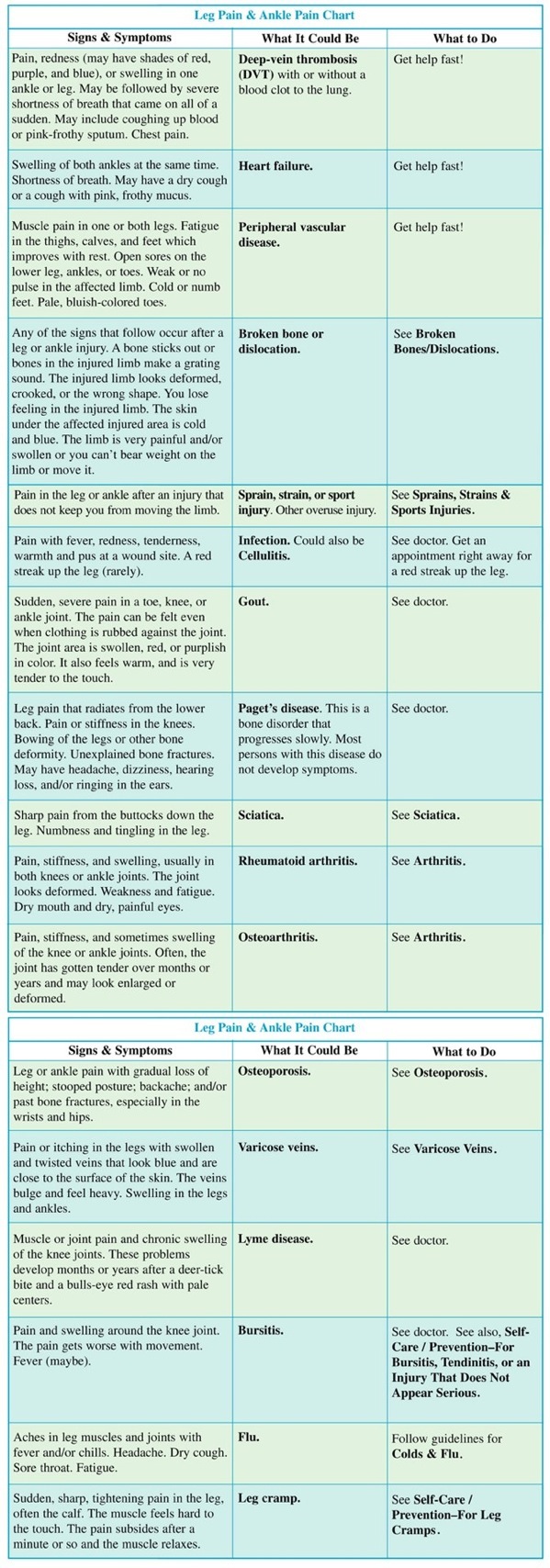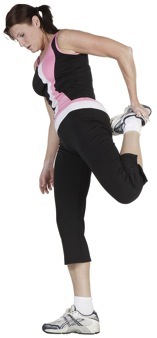

-
Muscle & Bone Problems
Leg Pain & Ankle Pain
Pain in the legs or ankles can range from mild to severe. The type and amount of pain depends on the cause.
Self-Care / Prevention
For Pain, in General
-
•Take an over-the-counter medicine for pain as directed on the label. If the pain is not better after a few doses, call your doctor.
-
•Use a heating pad (set on low), a hot pack, or a moist, warm towel on the area of pain. If the pain is due to an injury, don’t use heat for 48 hours. Use R.I.C.E. (See below.)
R.I.C.E.
-
•Rest the injured area for 24 to 48 hours.
-
•Ice the area as soon as possible and keep doing so for 10 minutes every 2 hours for the first 48 hours. Use an ice pack, ice in a heavy plastic bag with a little water, a bag of frozen vegetables, etc.
-
•Compress the area. Wrap with an elastic bandage. Do not cut off circulation. Remove the bandage every 3 to 4 hours, for 15 to 20 minutes each time.
-
•Elevate the area above heart level, if possible. Place it on a pillow, folded blanket, stack of newspapers, etc.
For Paget’s Disease
-
•If needed, take an over-the-counter medicine for pain as directed on the label.
-
•Take other medicines as prescribed by your doctor.
-
•Get regular checkups to detect hearing loss.

Good Sources of Magnesium
-
•Whole grain breads and cereals.
-
•Dried beans.
-
•Black-eyed peas.
-
•Nuts, especially peanuts.
-
•Wild rice.
-
•Tofu.
When you can, walk on grass instead of concrete.

To Help Prevent Leg Pain & Ankle Pain
-
•Get to and stay at a healthy weight.
-
•Get regular exercise. This helps to keep ankle and leg muscles strong.
-
•Before you exercise, stretch and warm up your muscles. When you are done, cool them down.
-
•Protect your knees. Use knee pads when you garden or kneel. Always land on bent knees when jumping. Avoid deep knee bend exercises.
-
•Don’t wear high-heeled shoes. Keep your shoes in proper shape.
-
•Take good care of your feet.
For Leg Cramps
-
•Walk on the leg.
-
•Shake the leg and then elevate it.
-
•Sit with your leg flat on the floor. Flex your foot upward, then toward your knee. Reach for your toes and pull them toward your knee. This stretches the calf muscles.
-
•Have someone massage the cramped muscle gently, but firmly.
-
•Apply a heating pad (set on low), a hot pack, or moist, warm towel to the muscle cramp.
-
•Rub the muscle that is cramping. Rub upward from the ankle toward the heart. (Note: Do not rub a leg if you suspect phlebitis or thrombosis.)

-
•Get good sources of calcium, potassium, and magnesium. See lists below. Take calcium, potassium, and magnesium as advised by your doctor.
-
•Drink plenty of water and other fluids. Limit drinks with caffeine. Avoid drinks with alcohol. Doing these things can help prevent dehydration which could cause leg cramps.
-
•Warm up your muscles before you exercise. Cool down your muscles when you are done.
-
•With your doctor’s okay, wear elastic stockings while you are awake.
-
•Before you go to bed, stretch your calf muscles. Here’s one way to do this:
-
-Stand an arm’s length away from a wall. Lean against it with the palms of your hands.
-
-Bend your left knee. Keep your right leg straight behind you. Keep both feet flat on the floor and your back straight.
-
-Lean forward. Feel your right calf muscle stretch. Hold the stretch as you count to 10 slowly.
-
-Repeat, switching leg positions.
-
•Another way to stretch your calf muscles is to ride a stationary bicycle for a few minutes.
-
•Take a warm bath before bedtime.
-
•Sleep with loose-fitting blankets and night clothes. Keep your legs warm.
-
•If you have severe leg cramps or get them often, tell your doctor. Ask if any medication you take could cause your leg cramps. Ask for ways to treat your leg cramps.
Good Sources of Calcium
-
•Nonfat milks.
-
•Cheeses.
-
•Yogurts.
-
•Calcium-fortified cereals and juices.
-
•Collard greens, broccoli, and spinach.
-
•Tofu, if calcium is used in processing.
Good Sources of Potassium
-
•Citrus fruits and juices.
-
•Bananas.
-
•Potatoes.
-
•Bran cereals.
-
•Fish.





Copyright © 2009, American Institute for Preventive Medicine. All rights reserved.